Analysis of Human Resource Strategy Alignment with Corporate Strategy
VerifiedAdded on 2020/05/04
|8
|1851
|147
Essay
AI Summary
This essay delves into the critical relationship between Human Resource (HR) strategy and corporate strategy, emphasizing the need for alignment to achieve organizational success and competitive advantage. The introduction highlights the common oversight of HR as merely administrative, arguing for its strategic importance in achieving business objectives. The discussion section explores strategy alignment as the integration of visions, missions, goals, and objectives with organizational operations, supported by several journal articles and real-world examples. The essay references studies and examples from companies like Coles and Sportsdirect to illustrate how HR strategies can either support or hinder corporate initiatives. The essay concludes by reiterating that HR should extend beyond administrative functions, focusing on its role in strategic planning and implementation, and emphasizing the value it brings to the firm. The essay underscores the importance of measuring HR's impact from a business perspective and its contribution to the bottom line.
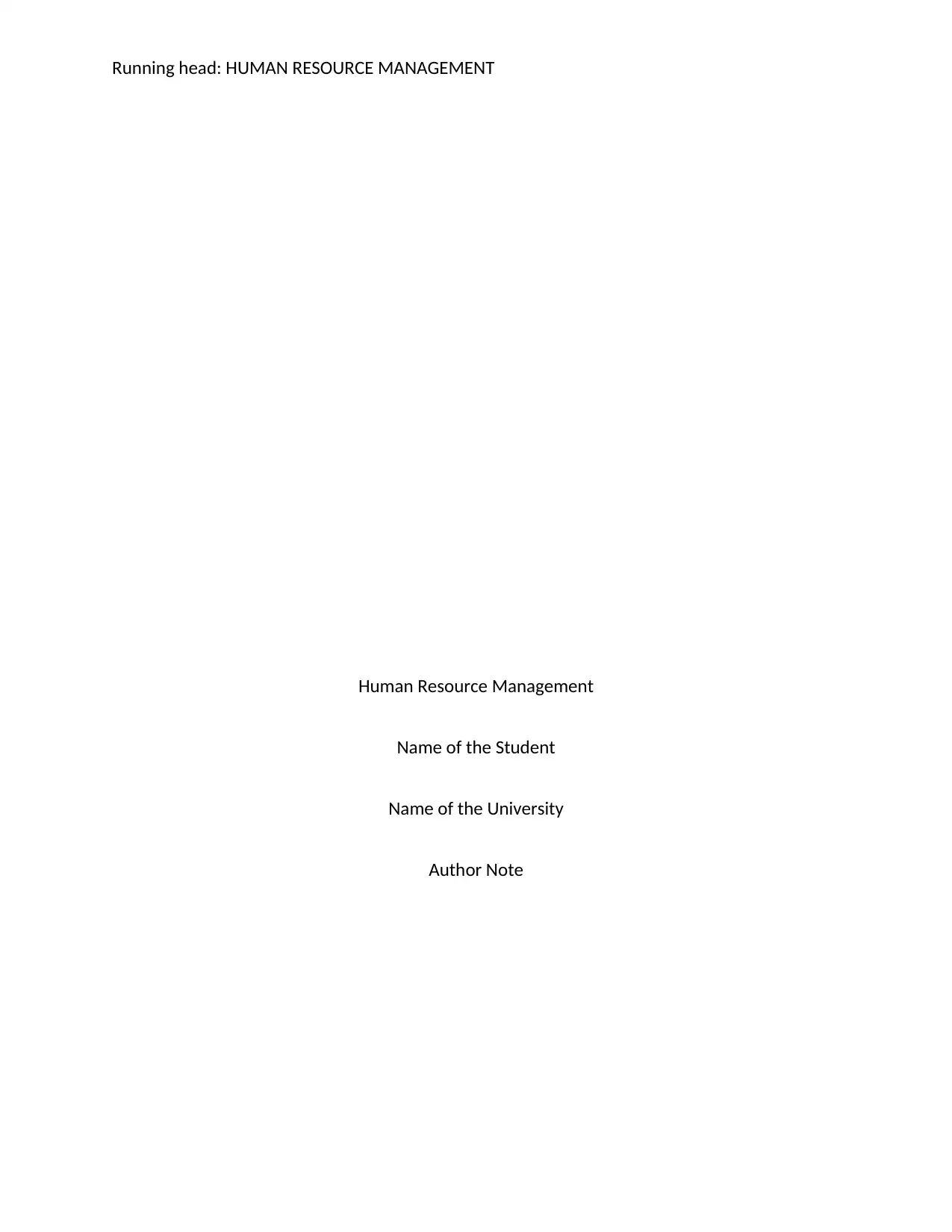
Running head: HUMAN RESOURCE MANAGEMENT
Human Resource Management
Name of the Student
Name of the University
Author Note
Human Resource Management
Name of the Student
Name of the University
Author Note
Paraphrase This Document
Need a fresh take? Get an instant paraphrase of this document with our AI Paraphraser
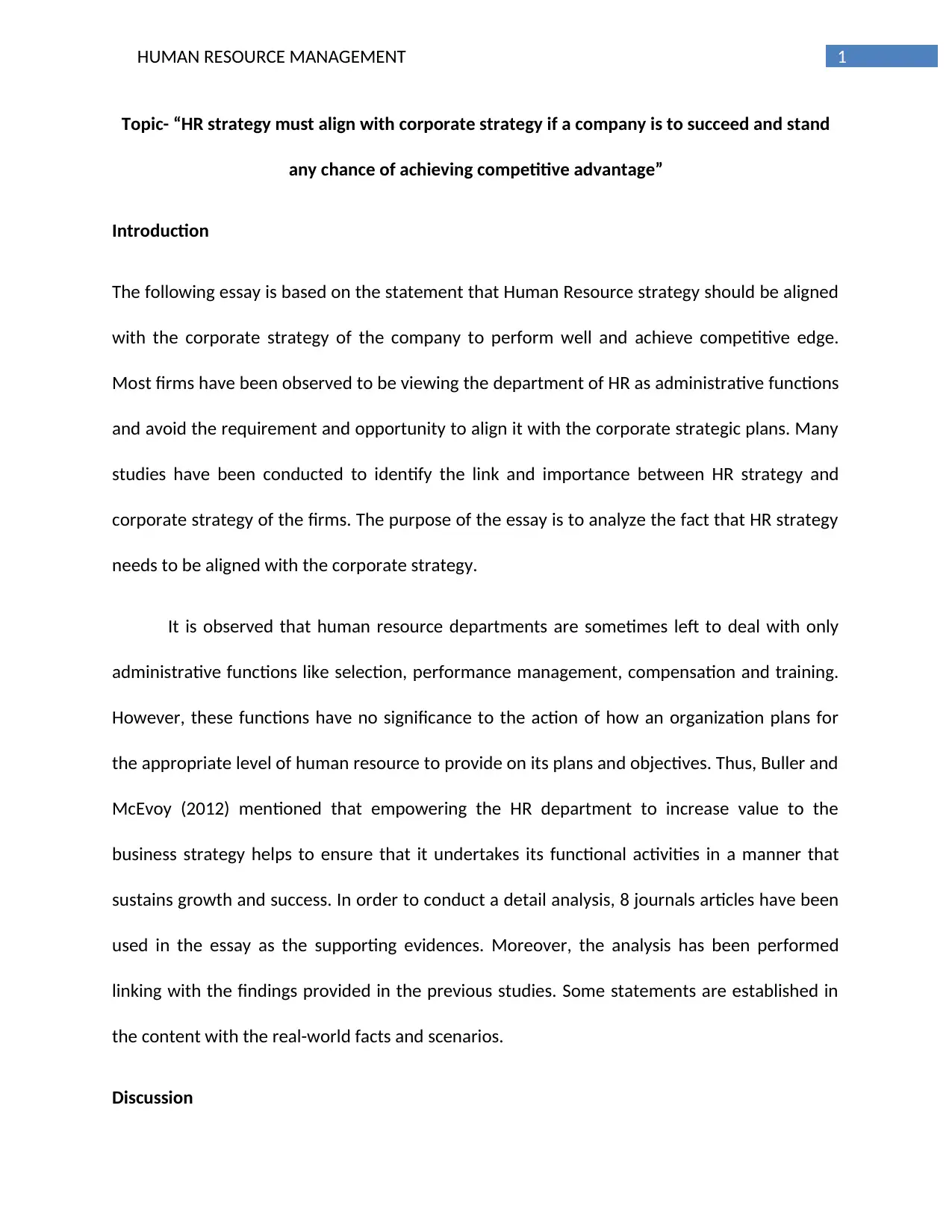
1HUMAN RESOURCE MANAGEMENT
Topic- “HR strategy must align with corporate strategy if a company is to succeed and stand
any chance of achieving competitive advantage”
Introduction
The following essay is based on the statement that Human Resource strategy should be aligned
with the corporate strategy of the company to perform well and achieve competitive edge.
Most firms have been observed to be viewing the department of HR as administrative functions
and avoid the requirement and opportunity to align it with the corporate strategic plans. Many
studies have been conducted to identify the link and importance between HR strategy and
corporate strategy of the firms. The purpose of the essay is to analyze the fact that HR strategy
needs to be aligned with the corporate strategy.
It is observed that human resource departments are sometimes left to deal with only
administrative functions like selection, performance management, compensation and training.
However, these functions have no significance to the action of how an organization plans for
the appropriate level of human resource to provide on its plans and objectives. Thus, Buller and
McEvoy (2012) mentioned that empowering the HR department to increase value to the
business strategy helps to ensure that it undertakes its functional activities in a manner that
sustains growth and success. In order to conduct a detail analysis, 8 journals articles have been
used in the essay as the supporting evidences. Moreover, the analysis has been performed
linking with the findings provided in the previous studies. Some statements are established in
the content with the real-world facts and scenarios.
Discussion
Topic- “HR strategy must align with corporate strategy if a company is to succeed and stand
any chance of achieving competitive advantage”
Introduction
The following essay is based on the statement that Human Resource strategy should be aligned
with the corporate strategy of the company to perform well and achieve competitive edge.
Most firms have been observed to be viewing the department of HR as administrative functions
and avoid the requirement and opportunity to align it with the corporate strategic plans. Many
studies have been conducted to identify the link and importance between HR strategy and
corporate strategy of the firms. The purpose of the essay is to analyze the fact that HR strategy
needs to be aligned with the corporate strategy.
It is observed that human resource departments are sometimes left to deal with only
administrative functions like selection, performance management, compensation and training.
However, these functions have no significance to the action of how an organization plans for
the appropriate level of human resource to provide on its plans and objectives. Thus, Buller and
McEvoy (2012) mentioned that empowering the HR department to increase value to the
business strategy helps to ensure that it undertakes its functional activities in a manner that
sustains growth and success. In order to conduct a detail analysis, 8 journals articles have been
used in the essay as the supporting evidences. Moreover, the analysis has been performed
linking with the findings provided in the previous studies. Some statements are established in
the content with the real-world facts and scenarios.
Discussion
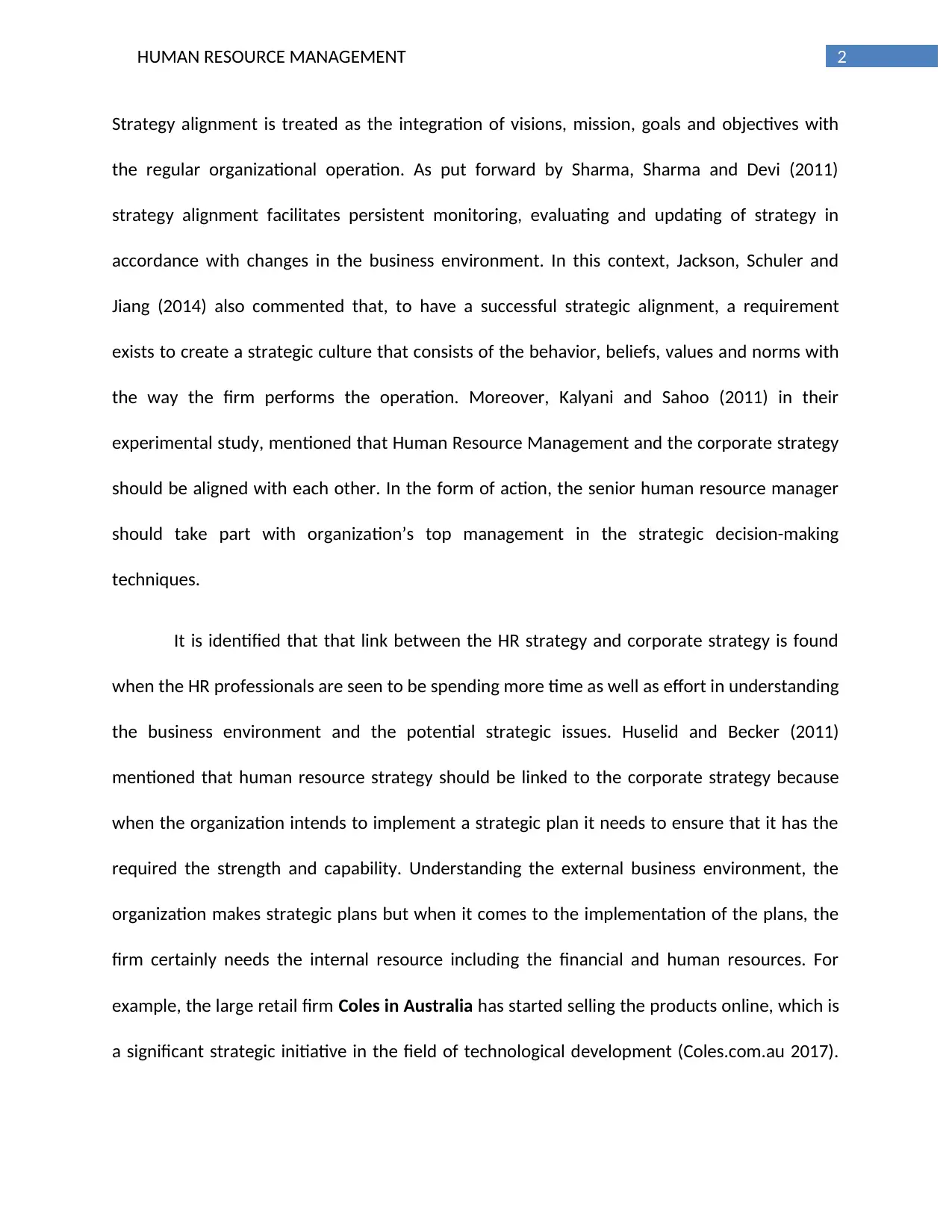
2HUMAN RESOURCE MANAGEMENT
Strategy alignment is treated as the integration of visions, mission, goals and objectives with
the regular organizational operation. As put forward by Sharma, Sharma and Devi (2011)
strategy alignment facilitates persistent monitoring, evaluating and updating of strategy in
accordance with changes in the business environment. In this context, Jackson, Schuler and
Jiang (2014) also commented that, to have a successful strategic alignment, a requirement
exists to create a strategic culture that consists of the behavior, beliefs, values and norms with
the way the firm performs the operation. Moreover, Kalyani and Sahoo (2011) in their
experimental study, mentioned that Human Resource Management and the corporate strategy
should be aligned with each other. In the form of action, the senior human resource manager
should take part with organization’s top management in the strategic decision-making
techniques.
It is identified that that link between the HR strategy and corporate strategy is found
when the HR professionals are seen to be spending more time as well as effort in understanding
the business environment and the potential strategic issues. Huselid and Becker (2011)
mentioned that human resource strategy should be linked to the corporate strategy because
when the organization intends to implement a strategic plan it needs to ensure that it has the
required the strength and capability. Understanding the external business environment, the
organization makes strategic plans but when it comes to the implementation of the plans, the
firm certainly needs the internal resource including the financial and human resources. For
example, the large retail firm Coles in Australia has started selling the products online, which is
a significant strategic initiative in the field of technological development (Coles.com.au 2017).
Strategy alignment is treated as the integration of visions, mission, goals and objectives with
the regular organizational operation. As put forward by Sharma, Sharma and Devi (2011)
strategy alignment facilitates persistent monitoring, evaluating and updating of strategy in
accordance with changes in the business environment. In this context, Jackson, Schuler and
Jiang (2014) also commented that, to have a successful strategic alignment, a requirement
exists to create a strategic culture that consists of the behavior, beliefs, values and norms with
the way the firm performs the operation. Moreover, Kalyani and Sahoo (2011) in their
experimental study, mentioned that Human Resource Management and the corporate strategy
should be aligned with each other. In the form of action, the senior human resource manager
should take part with organization’s top management in the strategic decision-making
techniques.
It is identified that that link between the HR strategy and corporate strategy is found
when the HR professionals are seen to be spending more time as well as effort in understanding
the business environment and the potential strategic issues. Huselid and Becker (2011)
mentioned that human resource strategy should be linked to the corporate strategy because
when the organization intends to implement a strategic plan it needs to ensure that it has the
required the strength and capability. Understanding the external business environment, the
organization makes strategic plans but when it comes to the implementation of the plans, the
firm certainly needs the internal resource including the financial and human resources. For
example, the large retail firm Coles in Australia has started selling the products online, which is
a significant strategic initiative in the field of technological development (Coles.com.au 2017).
⊘ This is a preview!⊘
Do you want full access?
Subscribe today to unlock all pages.

Trusted by 1+ million students worldwide
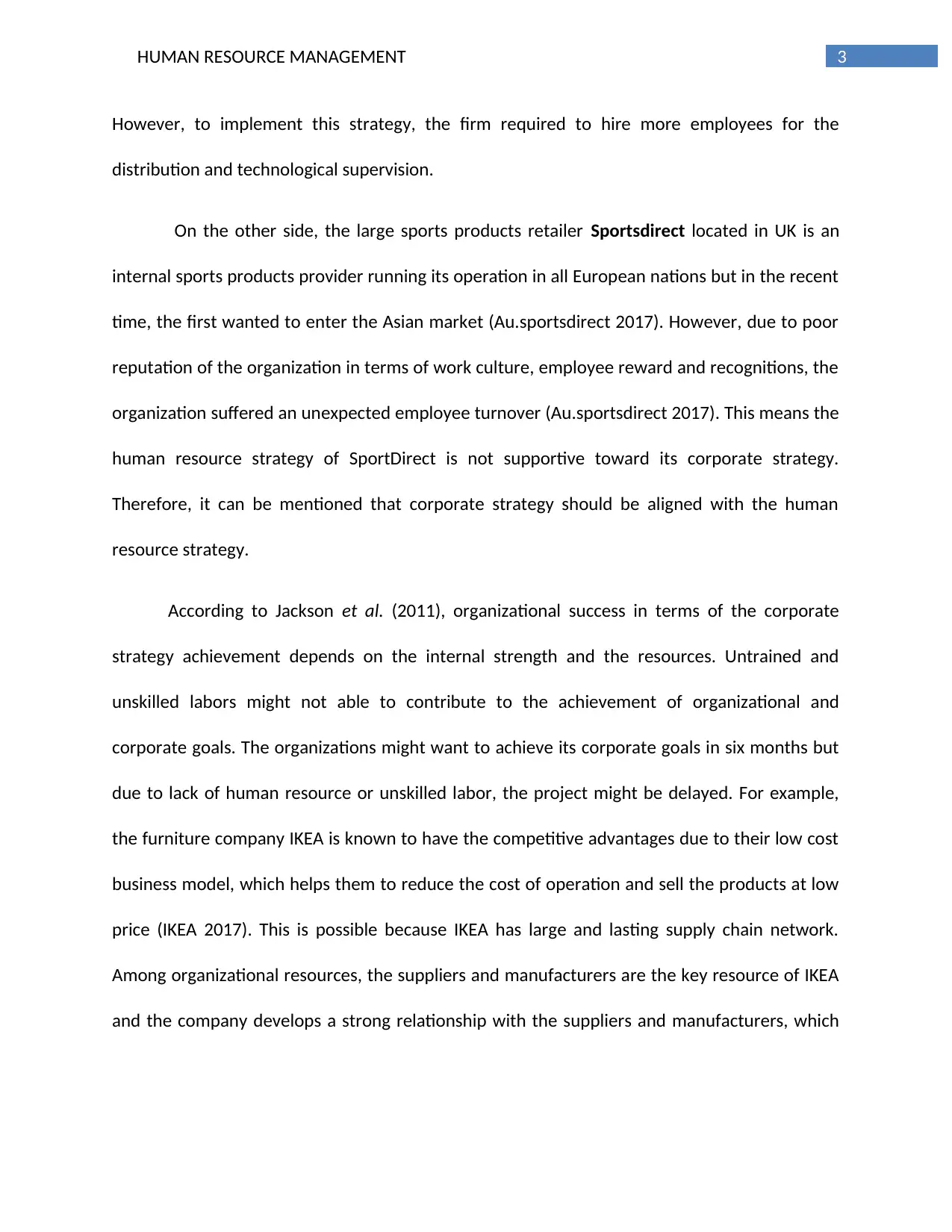
3HUMAN RESOURCE MANAGEMENT
However, to implement this strategy, the firm required to hire more employees for the
distribution and technological supervision.
On the other side, the large sports products retailer Sportsdirect located in UK is an
internal sports products provider running its operation in all European nations but in the recent
time, the first wanted to enter the Asian market (Au.sportsdirect 2017). However, due to poor
reputation of the organization in terms of work culture, employee reward and recognitions, the
organization suffered an unexpected employee turnover (Au.sportsdirect 2017). This means the
human resource strategy of SportDirect is not supportive toward its corporate strategy.
Therefore, it can be mentioned that corporate strategy should be aligned with the human
resource strategy.
According to Jackson et al. (2011), organizational success in terms of the corporate
strategy achievement depends on the internal strength and the resources. Untrained and
unskilled labors might not able to contribute to the achievement of organizational and
corporate goals. The organizations might want to achieve its corporate goals in six months but
due to lack of human resource or unskilled labor, the project might be delayed. For example,
the furniture company IKEA is known to have the competitive advantages due to their low cost
business model, which helps them to reduce the cost of operation and sell the products at low
price (IKEA 2017). This is possible because IKEA has large and lasting supply chain network.
Among organizational resources, the suppliers and manufacturers are the key resource of IKEA
and the company develops a strong relationship with the suppliers and manufacturers, which
However, to implement this strategy, the firm required to hire more employees for the
distribution and technological supervision.
On the other side, the large sports products retailer Sportsdirect located in UK is an
internal sports products provider running its operation in all European nations but in the recent
time, the first wanted to enter the Asian market (Au.sportsdirect 2017). However, due to poor
reputation of the organization in terms of work culture, employee reward and recognitions, the
organization suffered an unexpected employee turnover (Au.sportsdirect 2017). This means the
human resource strategy of SportDirect is not supportive toward its corporate strategy.
Therefore, it can be mentioned that corporate strategy should be aligned with the human
resource strategy.
According to Jackson et al. (2011), organizational success in terms of the corporate
strategy achievement depends on the internal strength and the resources. Untrained and
unskilled labors might not able to contribute to the achievement of organizational and
corporate goals. The organizations might want to achieve its corporate goals in six months but
due to lack of human resource or unskilled labor, the project might be delayed. For example,
the furniture company IKEA is known to have the competitive advantages due to their low cost
business model, which helps them to reduce the cost of operation and sell the products at low
price (IKEA 2017). This is possible because IKEA has large and lasting supply chain network.
Among organizational resources, the suppliers and manufacturers are the key resource of IKEA
and the company develops a strong relationship with the suppliers and manufacturers, which
Paraphrase This Document
Need a fresh take? Get an instant paraphrase of this document with our AI Paraphraser
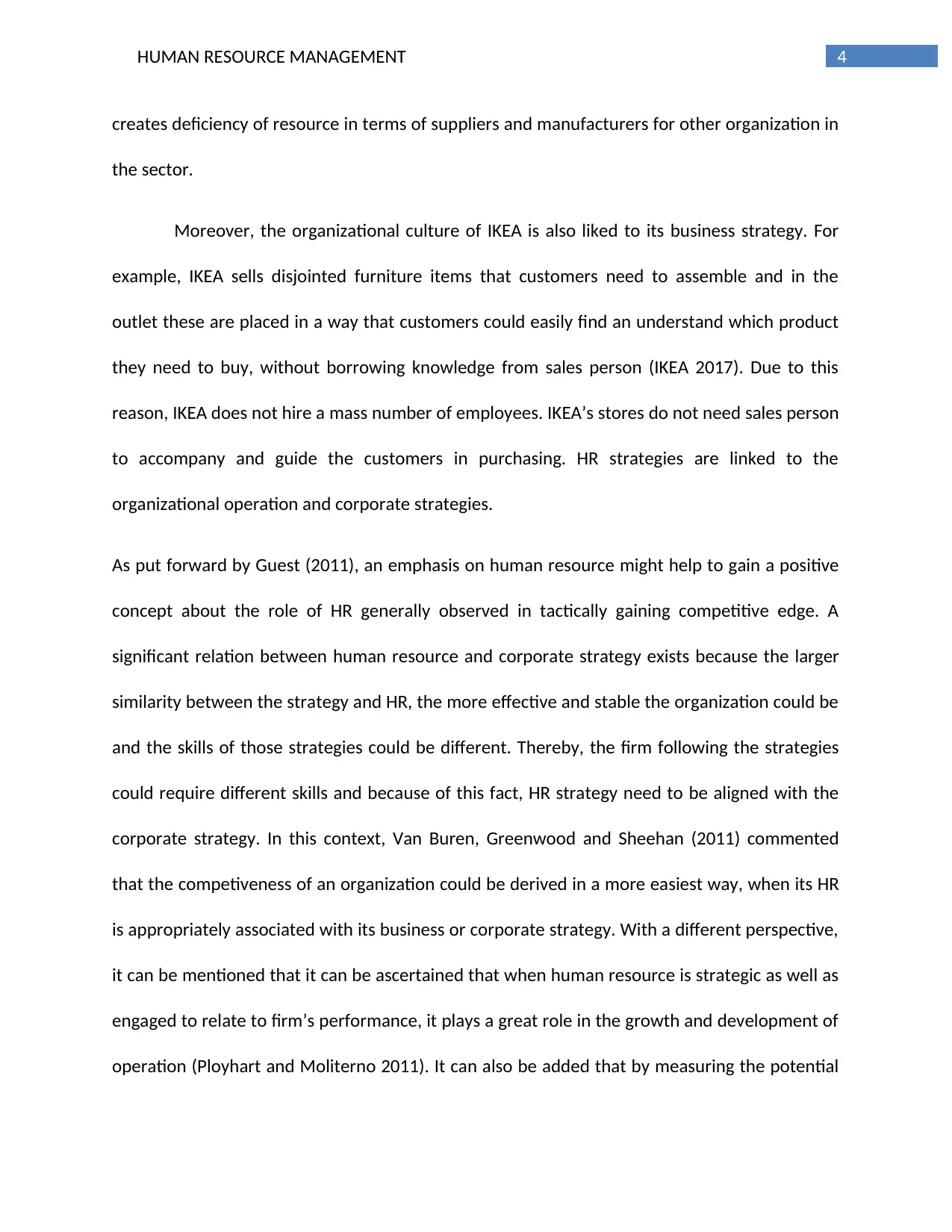
4HUMAN RESOURCE MANAGEMENT
creates deficiency of resource in terms of suppliers and manufacturers for other organization in
the sector.
Moreover, the organizational culture of IKEA is also liked to its business strategy. For
example, IKEA sells disjointed furniture items that customers need to assemble and in the
outlet these are placed in a way that customers could easily find an understand which product
they need to buy, without borrowing knowledge from sales person (IKEA 2017). Due to this
reason, IKEA does not hire a mass number of employees. IKEA’s stores do not need sales person
to accompany and guide the customers in purchasing. HR strategies are linked to the
organizational operation and corporate strategies.
As put forward by Guest (2011), an emphasis on human resource might help to gain a positive
concept about the role of HR generally observed in tactically gaining competitive edge. A
significant relation between human resource and corporate strategy exists because the larger
similarity between the strategy and HR, the more effective and stable the organization could be
and the skills of those strategies could be different. Thereby, the firm following the strategies
could require different skills and because of this fact, HR strategy need to be aligned with the
corporate strategy. In this context, Van Buren, Greenwood and Sheehan (2011) commented
that the competiveness of an organization could be derived in a more easiest way, when its HR
is appropriately associated with its business or corporate strategy. With a different perspective,
it can be mentioned that it can be ascertained that when human resource is strategic as well as
engaged to relate to firm’s performance, it plays a great role in the growth and development of
operation (Ployhart and Moliterno 2011). It can also be added that by measuring the potential
creates deficiency of resource in terms of suppliers and manufacturers for other organization in
the sector.
Moreover, the organizational culture of IKEA is also liked to its business strategy. For
example, IKEA sells disjointed furniture items that customers need to assemble and in the
outlet these are placed in a way that customers could easily find an understand which product
they need to buy, without borrowing knowledge from sales person (IKEA 2017). Due to this
reason, IKEA does not hire a mass number of employees. IKEA’s stores do not need sales person
to accompany and guide the customers in purchasing. HR strategies are linked to the
organizational operation and corporate strategies.
As put forward by Guest (2011), an emphasis on human resource might help to gain a positive
concept about the role of HR generally observed in tactically gaining competitive edge. A
significant relation between human resource and corporate strategy exists because the larger
similarity between the strategy and HR, the more effective and stable the organization could be
and the skills of those strategies could be different. Thereby, the firm following the strategies
could require different skills and because of this fact, HR strategy need to be aligned with the
corporate strategy. In this context, Van Buren, Greenwood and Sheehan (2011) commented
that the competiveness of an organization could be derived in a more easiest way, when its HR
is appropriately associated with its business or corporate strategy. With a different perspective,
it can be mentioned that it can be ascertained that when human resource is strategic as well as
engaged to relate to firm’s performance, it plays a great role in the growth and development of
operation (Ployhart and Moliterno 2011). It can also be added that by measuring the potential
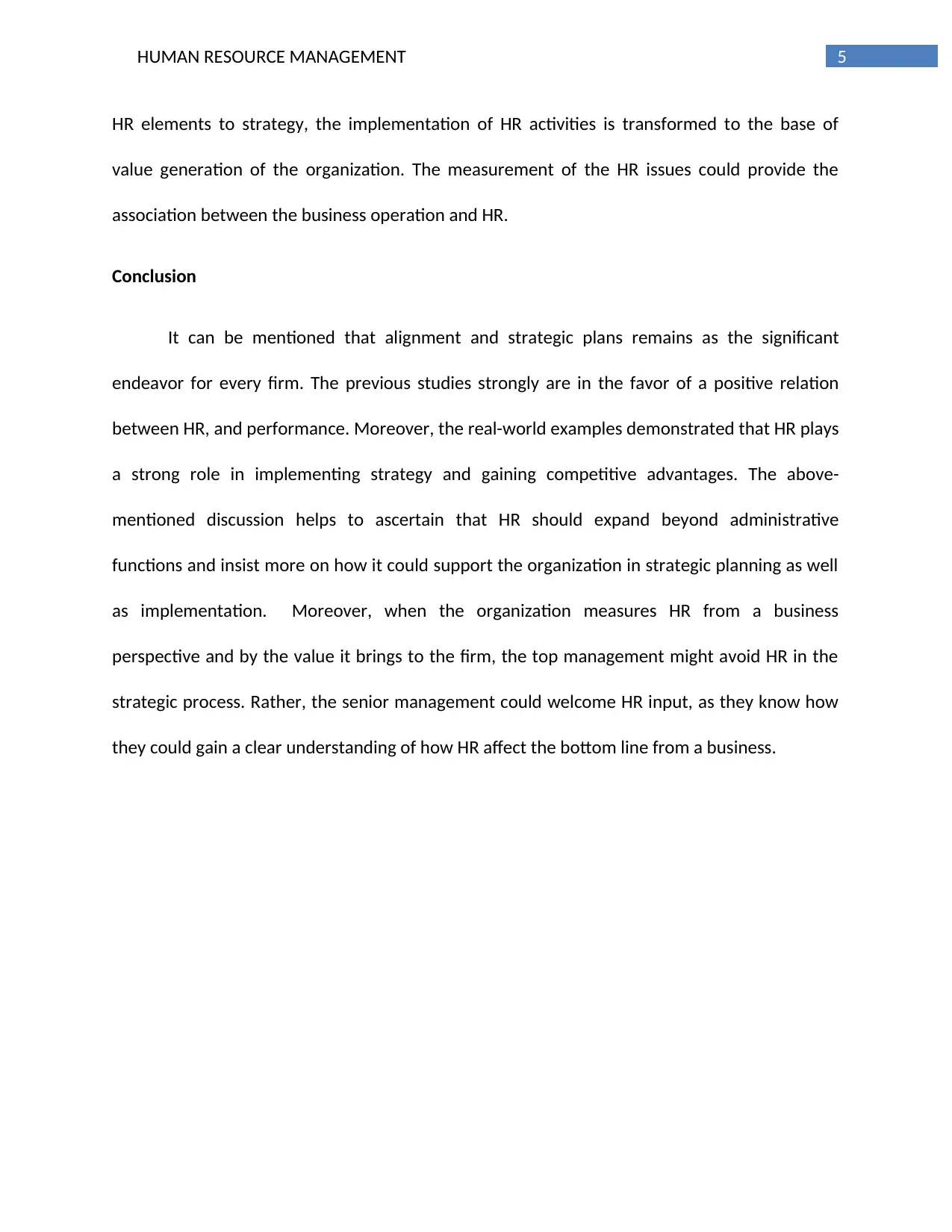
5HUMAN RESOURCE MANAGEMENT
HR elements to strategy, the implementation of HR activities is transformed to the base of
value generation of the organization. The measurement of the HR issues could provide the
association between the business operation and HR.
Conclusion
It can be mentioned that alignment and strategic plans remains as the significant
endeavor for every firm. The previous studies strongly are in the favor of a positive relation
between HR, and performance. Moreover, the real-world examples demonstrated that HR plays
a strong role in implementing strategy and gaining competitive advantages. The above-
mentioned discussion helps to ascertain that HR should expand beyond administrative
functions and insist more on how it could support the organization in strategic planning as well
as implementation. Moreover, when the organization measures HR from a business
perspective and by the value it brings to the firm, the top management might avoid HR in the
strategic process. Rather, the senior management could welcome HR input, as they know how
they could gain a clear understanding of how HR affect the bottom line from a business.
HR elements to strategy, the implementation of HR activities is transformed to the base of
value generation of the organization. The measurement of the HR issues could provide the
association between the business operation and HR.
Conclusion
It can be mentioned that alignment and strategic plans remains as the significant
endeavor for every firm. The previous studies strongly are in the favor of a positive relation
between HR, and performance. Moreover, the real-world examples demonstrated that HR plays
a strong role in implementing strategy and gaining competitive advantages. The above-
mentioned discussion helps to ascertain that HR should expand beyond administrative
functions and insist more on how it could support the organization in strategic planning as well
as implementation. Moreover, when the organization measures HR from a business
perspective and by the value it brings to the firm, the top management might avoid HR in the
strategic process. Rather, the senior management could welcome HR input, as they know how
they could gain a clear understanding of how HR affect the bottom line from a business.
⊘ This is a preview!⊘
Do you want full access?
Subscribe today to unlock all pages.

Trusted by 1+ million students worldwide
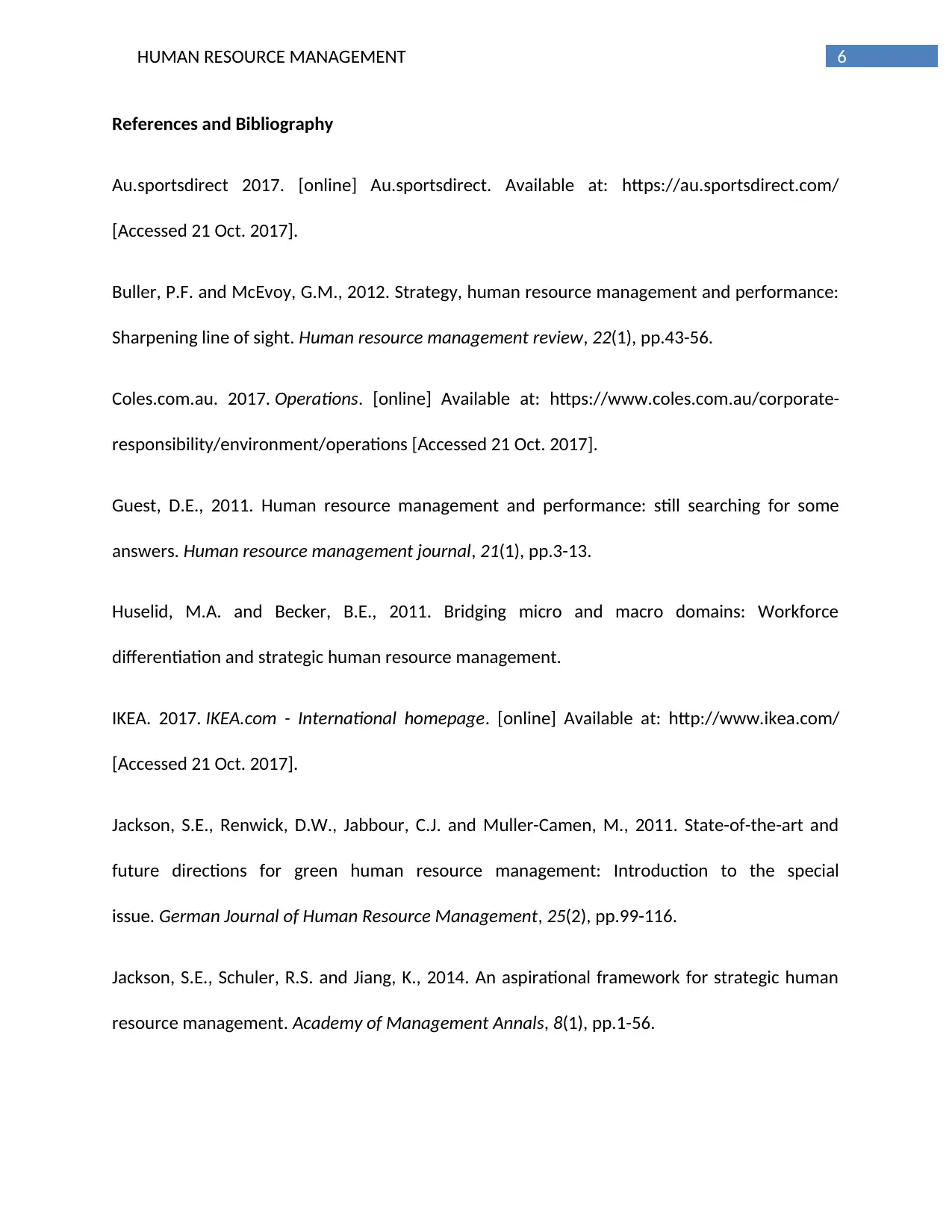
6HUMAN RESOURCE MANAGEMENT
References and Bibliography
Au.sportsdirect 2017. [online] Au.sportsdirect. Available at: https://au.sportsdirect.com/
[Accessed 21 Oct. 2017].
Buller, P.F. and McEvoy, G.M., 2012. Strategy, human resource management and performance:
Sharpening line of sight. Human resource management review, 22(1), pp.43-56.
Coles.com.au. 2017. Operations. [online] Available at: https://www.coles.com.au/corporate-
responsibility/environment/operations [Accessed 21 Oct. 2017].
Guest, D.E., 2011. Human resource management and performance: still searching for some
answers. Human resource management journal, 21(1), pp.3-13.
Huselid, M.A. and Becker, B.E., 2011. Bridging micro and macro domains: Workforce
differentiation and strategic human resource management.
IKEA. 2017. IKEA.com - International homepage. [online] Available at: http://www.ikea.com/
[Accessed 21 Oct. 2017].
Jackson, S.E., Renwick, D.W., Jabbour, C.J. and Muller-Camen, M., 2011. State-of-the-art and
future directions for green human resource management: Introduction to the special
issue. German Journal of Human Resource Management, 25(2), pp.99-116.
Jackson, S.E., Schuler, R.S. and Jiang, K., 2014. An aspirational framework for strategic human
resource management. Academy of Management Annals, 8(1), pp.1-56.
References and Bibliography
Au.sportsdirect 2017. [online] Au.sportsdirect. Available at: https://au.sportsdirect.com/
[Accessed 21 Oct. 2017].
Buller, P.F. and McEvoy, G.M., 2012. Strategy, human resource management and performance:
Sharpening line of sight. Human resource management review, 22(1), pp.43-56.
Coles.com.au. 2017. Operations. [online] Available at: https://www.coles.com.au/corporate-
responsibility/environment/operations [Accessed 21 Oct. 2017].
Guest, D.E., 2011. Human resource management and performance: still searching for some
answers. Human resource management journal, 21(1), pp.3-13.
Huselid, M.A. and Becker, B.E., 2011. Bridging micro and macro domains: Workforce
differentiation and strategic human resource management.
IKEA. 2017. IKEA.com - International homepage. [online] Available at: http://www.ikea.com/
[Accessed 21 Oct. 2017].
Jackson, S.E., Renwick, D.W., Jabbour, C.J. and Muller-Camen, M., 2011. State-of-the-art and
future directions for green human resource management: Introduction to the special
issue. German Journal of Human Resource Management, 25(2), pp.99-116.
Jackson, S.E., Schuler, R.S. and Jiang, K., 2014. An aspirational framework for strategic human
resource management. Academy of Management Annals, 8(1), pp.1-56.
Paraphrase This Document
Need a fresh take? Get an instant paraphrase of this document with our AI Paraphraser
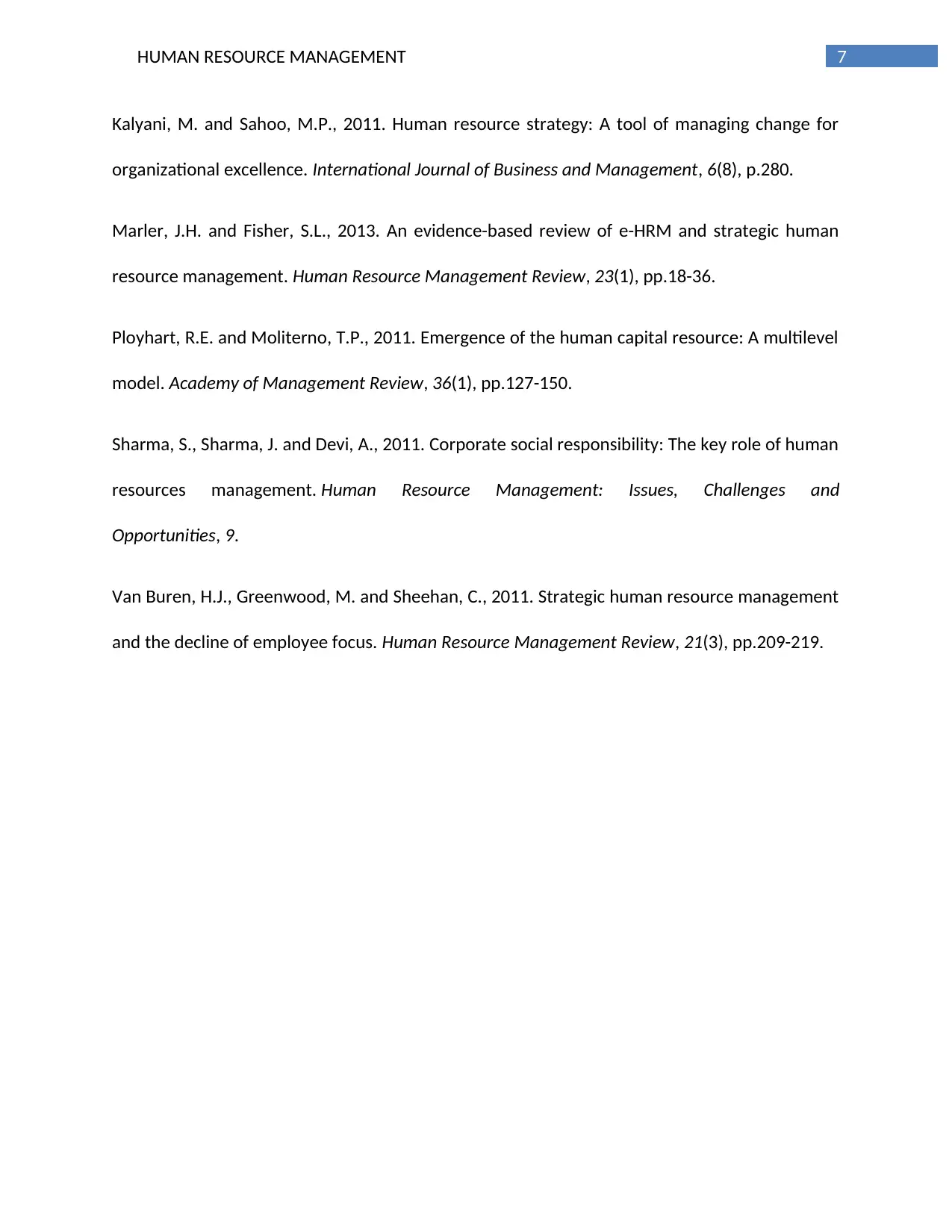
7HUMAN RESOURCE MANAGEMENT
Kalyani, M. and Sahoo, M.P., 2011. Human resource strategy: A tool of managing change for
organizational excellence. International Journal of Business and Management, 6(8), p.280.
Marler, J.H. and Fisher, S.L., 2013. An evidence-based review of e-HRM and strategic human
resource management. Human Resource Management Review, 23(1), pp.18-36.
Ployhart, R.E. and Moliterno, T.P., 2011. Emergence of the human capital resource: A multilevel
model. Academy of Management Review, 36(1), pp.127-150.
Sharma, S., Sharma, J. and Devi, A., 2011. Corporate social responsibility: The key role of human
resources management. Human Resource Management: Issues, Challenges and
Opportunities, 9.
Van Buren, H.J., Greenwood, M. and Sheehan, C., 2011. Strategic human resource management
and the decline of employee focus. Human Resource Management Review, 21(3), pp.209-219.
Kalyani, M. and Sahoo, M.P., 2011. Human resource strategy: A tool of managing change for
organizational excellence. International Journal of Business and Management, 6(8), p.280.
Marler, J.H. and Fisher, S.L., 2013. An evidence-based review of e-HRM and strategic human
resource management. Human Resource Management Review, 23(1), pp.18-36.
Ployhart, R.E. and Moliterno, T.P., 2011. Emergence of the human capital resource: A multilevel
model. Academy of Management Review, 36(1), pp.127-150.
Sharma, S., Sharma, J. and Devi, A., 2011. Corporate social responsibility: The key role of human
resources management. Human Resource Management: Issues, Challenges and
Opportunities, 9.
Van Buren, H.J., Greenwood, M. and Sheehan, C., 2011. Strategic human resource management
and the decline of employee focus. Human Resource Management Review, 21(3), pp.209-219.
1 out of 8
Related Documents
Your All-in-One AI-Powered Toolkit for Academic Success.
+13062052269
info@desklib.com
Available 24*7 on WhatsApp / Email
![[object Object]](/_next/static/media/star-bottom.7253800d.svg)
Unlock your academic potential
Copyright © 2020–2025 A2Z Services. All Rights Reserved. Developed and managed by ZUCOL.



